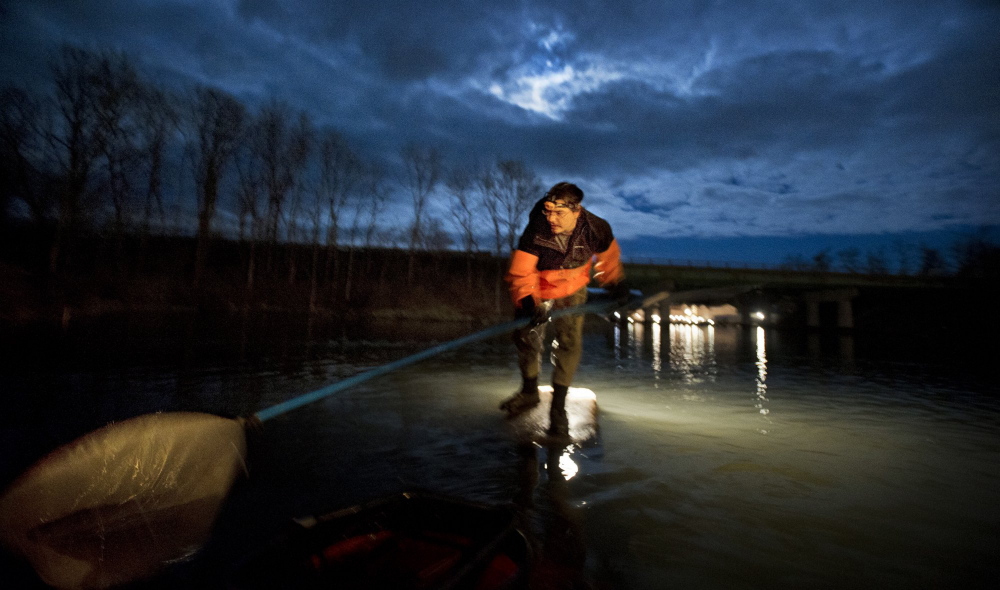Federal regulators will hear from Maine elver fishermen and state fisheries officials Monday in two public hearings that will help the government develop a plan to preserve one of Maine’s most valuable fisheries at a time of global concern over depleted eel populations.
The hearings in Hallowell and Brewer will be held by the Atlantic States Marine Fisheries Commission, which has the authority to set catch limits and establish other rules governing East Coast fisheries from Maine to Florida.
The panel will review its assessments of eel populations and harvests – frequently sore points among Maine’s elver fishermen. Commissioners also will provide an updated analysis of eel populations, with an eye toward fine-tuning management of the species at all stages of life, including glass (elvers), silver and yellow eels, said Kate Taylor, the commission’s senior fisheries management plan coordinator.
The commission’s plan for eel fisheries covers a wide range of potential management measures, “from maintaining the status quo to closure of the fishery and many options in between,” Taylor said.
The Maine Department of Marine Resources said preliminary figures show that fishermen harvested about 9,586 pounds of elvers in the season that ended May 31. That’s about half of recent years’ harvests. At the direction of the commission, DMR set a total harvest limit this year of 11,163 pounds, which was not reached. The agency also instituted a swipe-card system for fishermen and licensed dealers that tracked the harvest and sales and resulted in a 90 percent decline in illegal poaching, DMR said.
This year’s take was far below the record 20,764 pounds harvested in 2012, a catch that was valued at nearly $39 million and made the elver fishery second only to lobster in economic value. The harvest in 2013 was 18,076 pounds, valued at about $33 million. In those two years, the average price per pound approached $2,000, selling for $1,866 in 2012 and $1,821 in 2013. They were the highest returns since 1994, said Walter Watts, a marine resource scientist with DMR in Boothbay who is tracking the vacillations of the fishery from year to year.
The price per pound dropped significantly this year, but the seasonal dollar value and total harvest are still being calculated, Watts said.
The reduced take this year is a direct result of the state’s commitment to preserve the fishery, officials and fishermen said.
“Maine’s been making a lot of compromises,” said Mitchell Feigenbaum, co-founder of the American Eel Sustainability Association, an advocacy group for the fishery. He noted that a quota had been imposed and met this year, and said the association is willing to support the status quo because the state has been responsive to the issues facing the fishery.
Maine has shown it has “the ability and intent to properly manage the fishery,” he said.
While Feigenbaum concedes that stocks are depleted compared with historic levels, he said the population is stable now, and that the spawning stock is sufficient to replenish the eels being harvested. “Overfishing is not occurring,” he said.
But while Maine has taken steps to rein in harvest levels, eel populations around the world are in trouble. This month, the International Union for Conservation of Nature designated the Japanese eel as “endangered,” which could lead to trade restrictions or other protective measures. Japan, which has its own national “red list” of species that could go extinct, in 2013 also listed the eel as endangered.
Japan is the major market for elvers caught in Maine, which are shipped to the Far East as tiny specimens some 2 to 3 inches long and then raised to adulthood in farming operations.
If global conditions work to limit the supply of adult eels, that could drive up demand and the market value of young eels caught in Maine. That would put pressure on regulators and create temptations to increase the catch – either legally or illegally.
For Maine elver fishermen, catch limits and quotas have been sensitive subjects. Along with disputes over the accuracy of the data regarding Maine’s elver populations, those issues are expected to resurface at Monday’s hearings.
Management options being considered include quotas on glass and yellow eels, a catch cap for the yellow eel fishery, a moratorium on the glass eel fishery, and a seasonal closure and license cap for the silver eel fishery in the Delaware River in New York. An addendum provides allowances for glass eel harvesting for aquaculture purposes, and a conservation-based allocation program in which states can earn a glass eel quota by implementing programs that increase the navigable passage of glass eels, according to the federal commission.
The specific measures included in this and other, earlier management plans were established by 2010 assessments showing the American eel population had been depleted, said Taylor, the panel’s plan coordinator. The original plan and the changes that have been crafted so far have been aimed at reducing the mortality of eels and increasing the conservation of stocks across all life stages, she said.
After it is reviewed by all member states, the plan will return to the commission’s management board. Some 50 commissioners will sift through public comments and decide whether current regulations need to be changed. The proposed plan could be finalized and approved by Aug. 7, when the group meets in Alexandria, Virginia, Taylor said.
Send questions/comments to the editors.



Comments are no longer available on this story